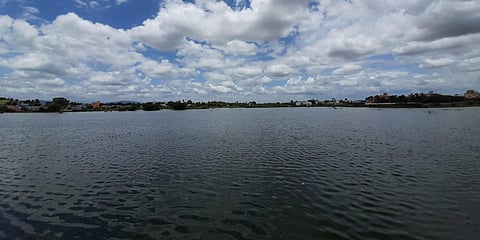

HYDERABAD: Hyderabad once had more than 250 manmade lakes in and around the city, but today the majority of them have been buried under concrete structures, and the existing lakes have transformed into toxic bodies of water. According to data from the Telangana State Pollution Control Board (TSPCB), as of February 2023, approximately 23 out of 185 lakes in the Greater Hyderabad Municipal Corporation (GHMC) limits have dried up, while the data from December 2022 reported seven dried-up lakes.
Anitha Agarawal, head of the Centre for Climate Change (CCC) division at Engineering Staff College of India (ESCI), said, “While beautification and management of major urban lakes like Durgam Cheruvu, Nallagandla and Gandipet among others are being carried out, there are several small lakes in the city which are being neglected. As the population is increasing, the vertical buildings and encroachments are also rising, resulting in the drying up of lakes. These urban water bodies play a key role in balancing the local environment by regulating the surplus floodwaters during monsoon periods and recharging groundwater sources along with offering invaluable aesthetic sense in the urban landscape.”
Some of the lakes that have dried up include Thouthu Kunta in Khajaguda, ISB lake in Gachibowli, Khanamet lake, Edgavani Kunta in Gopanpally and Neerla Cheruvu in Kothaguda.Water samples analysed by the TSPCB clearly indicate alarmingly high levels of COD, BOD, nitrates and phosphates in the lake waters. Dissolved oxygen levels are virtually non-existent, and filamentous bacteria have been found in all collected water samples. This situation demands immediate action not only to restore the identified lakes but also to assess the condition of other lakes in their respective basins, experts said.
The highest recorded BOD levels were 50 mg/L at Pedda Cheruvu in Khajaguda and 36 mg/L at Jamal Kunta in Shaikpet. Polluted lakes not only impact the local weather conditions but also contribute to climate change indirectly, experts added.“The changing lifestyles and the increasing availability of consumer products have a direct impact on the physical and chemical composition of domestic and wastewaters. In addition to the discharge from Sewage Treatment Plants (STPs), the way citizens dispose of waste contributes to the rising level of pollutants,” said Aggarwal.
She added that the accumulation of solid waste and chemical waste accelerates the growth of algae, which in turn affects the storage capacity of the lake.“Considering the presence of numerous small lakes in the city, maintaining them alone poses a significant challenge for GHMC officials. Therefore, establishing contracts with private companies and entrepreneurs can assist in effectively safeguarding and maintaining these lakes. Moreover, if the locals and municipalities take responsibility for the water bodies in their respective areas, it would greatly contribute to the successful maintenance of the lakes,” Aggarwal suggested.
Conserve RK Puram, Kapra lakes: Locals
The Federation of Northeastern Colonies of Secunderabad is urging authorities to address the issues of desilting RK Puram lake and restoring water levels to full capacity in Kapra lake. Despite minor beautification efforts initiated years ago at RK Puram lake, no significant progress has been made, leading frustrated residents to voice their concerns on Twitter on Sunday. A proposal to rejuvenate Kapra Lake had been discussed last year but no action can be seen on the ground, residents allege. Locals pointed out that the diversion of sewage and rainwater away from the lake has left it parched and vulnerable to high evaporation rates.